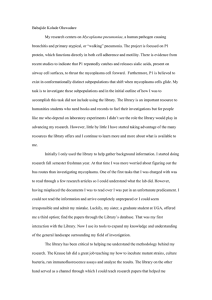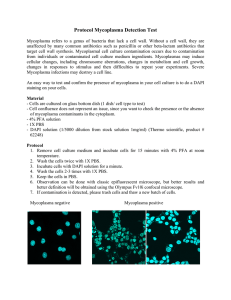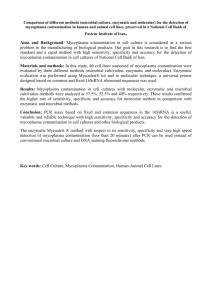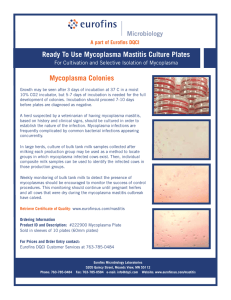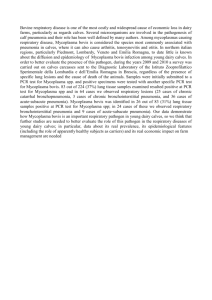- pelobiotech
advertisement
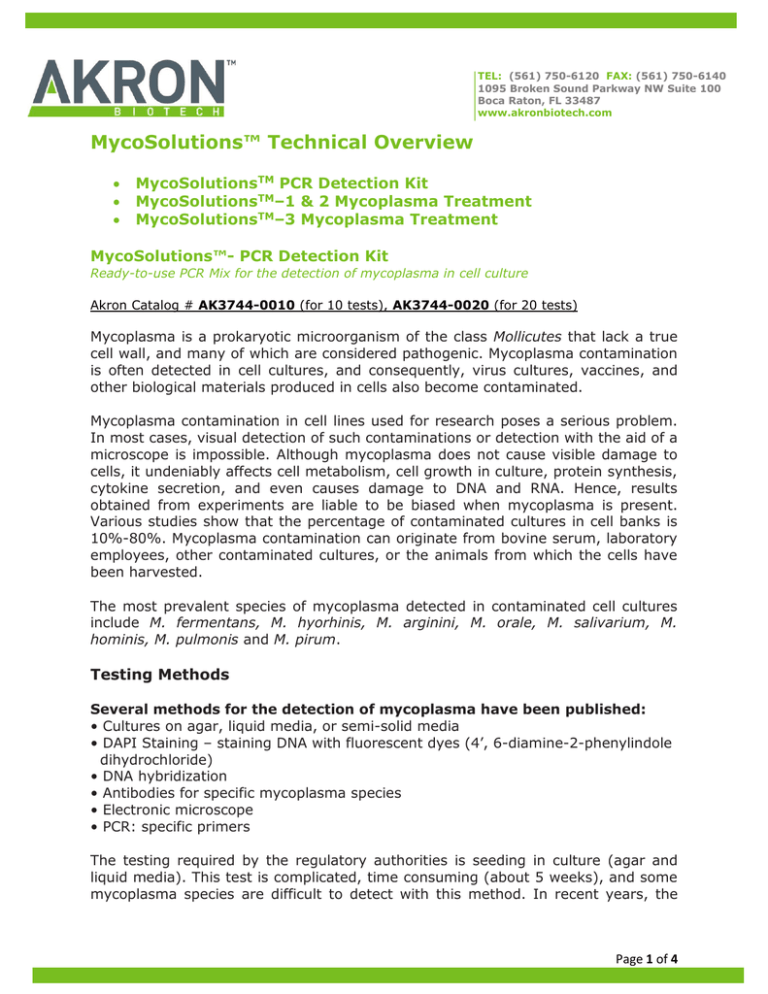
TEL: (561) 750-6120 FAX: (561) 750-6140 1095 Broken Sound Parkway NW Suite 100 Boca Raton, FL 33487 www.akronbiotech.com MycoSolutions™ Technical Overview MycoSolutionsTM PCR Detection Kit MycoSolutionsTM–1 & 2 Mycoplasma Treatment MycoSolutionsTM–3 Mycoplasma Treatment MycoSolutions™- PCR Detection Kit Ready-to-use PCR Mix for the detection of mycoplasma in cell culture Akron Catalog # AK3744-0010 (for 10 tests), AK3744-0020 (for 20 tests) Mycoplasma is a prokaryotic microorganism of the class Mollicutes that lack a true cell wall, and many of which are considered pathogenic. Mycoplasma contamination is often detected in cell cultures, and consequently, virus cultures, vaccines, and other biological materials produced in cells also become contaminated. Mycoplasma contamination in cell lines used for research poses a serious problem. In most cases, visual detection of such contaminations or detection with the aid of a microscope is impossible. Although mycoplasma does not cause visible damage to cells, it undeniably affects cell metabolism, cell growth in culture, protein synthesis, cytokine secretion, and even causes damage to DNA and RNA. Hence, results obtained from experiments are liable to be biased when mycoplasma is present. Various studies show that the percentage of contaminated cultures in cell banks is 10%-80%. Mycoplasma contamination can originate from bovine serum, laboratory employees, other contaminated cultures, or the animals from which the cells have been harvested. The most prevalent species of mycoplasma detected in contaminated cell cultures include M. fermentans, M. hyorhinis, M. arginini, M. orale, M. salivarium, M. hominis, M. pulmonis and M. pirum. Testing Methods Several methods for the detection of mycoplasma have been published: • Cultures on agar, liquid media, or semi-solid media • DAPI Staining – staining DNA with fluorescent dyes (4’, 6-diamine-2-phenylindole dihydrochloride) • DNA hybridization • Antibodies for specific mycoplasma species • Electronic microscope • PCR: specific primers The testing required by the regulatory authorities is seeding in culture (agar and liquid media). This test is complicated, time consuming (about 5 weeks), and some mycoplasma species are difficult to detect with this method. In recent years, the Page 1 of 4 TEL: (561) 750-6120 FAX: (561) 750-6140 1095 Broken Sound Parkway NW Suite 100 Boca Raton, FL 33487 www.akronbiotech.com disadvantages of these methods have been acknowledged (such as sensitivity, specificity and long and complex procedures), and use of PCR for the detection of contaminations in cell cultures has become increasingly widespread. Using PCR for the MycoSolutions Detection Kit PCR has been shown to be a highly sensitive, specific, and rapid method for the detection of mycoplasma contamination in cell cultures. Specific primers have been designed from DNA that is coded to the ribosomal RNA (16SrRNA). The gene sequences for RNA are considered conserved sequences and are similar in the various mycoplasma species, which have not undergone significant mutation. Consequently, primers can be designed for these areas, which are specific to the mycoplasma and will not detect bacterial or animal DNA sequences. The literature describes several PCR methods for the detection of mycoplasma, such as using a number of PCR primers to detect specific mycoplasma species, and nested PCR (two consecutive PCR cycles using different primers) to enhance sensitivity and specificity. The MycoSolutions PCR Detection Kit (Cat#AK3744), a PCR-based Mycoplasma detection kit, that simplifies testing and detection of mycoplasma contamination in cell cultures. The kit includes a unique reaction mix that contains all the ingredients required for PCR: nucleotides, primers, Taq Polymerase and magnesium. No prior preparations are required for PCR, other than the sample to be tested (centrifugation and suspension in the buffer supplied with the kit). After performing agarose gel electrophoresis, positive samples will yield a 270bp fragment. The test takes approximately three hours to complete. The primers have been designed to detect the mycoplasma species responsible for most contaminations in cell cultures (including Acholeplasma). The primers were tested and found to be specific to mycoplasmatic DNA, and do not react with animal or bacterial DNA. In sensitivity tests for the detection of defined mycoplasmas, the MycoSolutions PCR Detection Kit was found to be the most sensitive in comparison to other test kits currently available on the market (Table 1). The ability to routinely conduct rapid and simple tests to detect mycoplasma contamination in cell cultures facilitates the eradication or treatment of contaminated cells. Table 1: Minimal concentration of mycoplasma detected with MycoSolutions PCR Detection Kit M. fermentans 240 CFU/ml M. capricolum 110 CFU/ml M. penetrans 200 CFU/ml M. hyorhinis 210 CFU/ml Page 2 of 4 TEL: (561) 750-6120 FAX: (561) 750-6140 1095 Broken Sound Parkway NW Suite 100 Boca Raton, FL 33487 www.akronbiotech.com Using Antibiotics to Disinfect Cell Cultures The increasingly widespread use of more sophisticated and sensitive methods for the detection of mycoplasma contamination in cell cultures has resulted in contamination being detected in numerous cultures. This raises the issue of how to eliminate mycoplasma contamination. Naturally, the ideal solution is to discard the contaminated cells. However, if the cells that are stored in liquid nitrogen are also contaminated, a solution is required for eliminating the mycoplasma and preparing a new cell bank, particularly if the cells are unique and the result of extensive work. A number of effective methods for the elimination of mycoplasma contamination in cell cultures have been published, such as: • Treatment with specific hyperimmune serum (antibodies). • Passage of contaminated cells in thymus-deficient mice. • Exposure to analogs of nucleic acids that prevent reproduction of mycoplasma. • Treatment with antibiotics. • Exposure of contaminated cells to mouse macrophages. • A technique that combines growing cells on soft agar and treatment with antibiotics. The preferred method in terms of simplicity is treatment with antibiotics, which do not damage or alter cells. Antibiotics such as penicillin, which attacks bacterial cell walls, are ineffective in this instance, since mycoplasma lacks a true cell wall. Several antibiotics eliminate mycoplasma effectively, such as: Tylosin, Neomycin, Tetracycline and Gentamycin. However, the efficacy of these antibiotics is restricted to specific mycoplasma species and frequently only reduce the concentration of mycoplasmas rather than disinfect the cell culture. Hence, as soon as treatment is concluded, contamination will recur. Two methods are recommended for treating contaminated cells with antibiotics. The first is based on alternating treatment with two types of antibiotics, and the second on treatment with one type of antibiotic. MycoSolutionsTM–1 & 2 Mycoplasma Treatment Akron Catalog # AK8360-0010 (10mL), AK8360-0020 (20ml), AK8360-0100 (100ml) MycoSolutions™-1 is a pleuromutilin antibiotic and MycoSolutions™-2 is a member of the broad-spectrum tetracycline antibiotics. MycoSolutions™-1 is a prokaryotic ribosome inhibitor that acts by blocking the initiation of polypeptide chain formation, therefore preventing the synthesis of key enzymes and other proteins. MycoSolutions™-1 shows footprints that affect the nucleotides in Page 3 of 4 TEL: (561) 750-6120 FAX: (561) 750-6140 1095 Broken Sound Parkway NW Suite 100 Boca Raton, FL 33487 www.akronbiotech.com domain V of 23S rRNA that has been implicated as part of the dynamically mobile peptidyltransferase center by completely clocking peptide bond formation. Specifically, it blocks the peptidyltransferase center on the ribosome. The Mode of Action (MOA) of MycoSolutions™-2 inhibits bacterial protein synthesis by blocking the attachment of the transfer RNA-amino acid at the Asite on the 30S bacterial ribosome. More precisely MycoSolutions™-1&2 is an inhibitor of the codon-anticodon interaction (i.e. the incoming aminoacyl-tRNAs to the A-site). Selectivity against bacterial versus eukaryotic ribosomes is due to both structural differences in RNA of the ribosomal subunits and selective concentration in susceptible bacterial cells. MycoSolutionsTM–3 Mycoplasma Treatment Akron Catalog # AK5240-0010 (10mL), AK5240-0020 (20ml), AK5240-0100 (100ml) MycoSolutions-3, a 4-quinolone, is one of the newer compounds of the fluroquinolone class, broad-spectrum, bactericidal antibiotics. It is one of several synthetic antibiotics that prevents, treats, and controls contamination of cell lines by Mycoplasma species. Ciprofloxacin's Mode of Action (MOA) inhibits bacterial nuclear DNA synthesis whose target is DNA gyrase (topoisomerase II). DNA gyrase is an enzyme that is responsible for the growth, repair and reproduction mechanisms of the bacteria. Specifically, DNA gyrase is responsible for supercoiling and uncoiling of the DNA so that the DNA can twist in a number of chromosomal domains and seal around an RNA core. Supercoiling of the DNA allows the long DNA molecule to fit into the cell. Uncoiling of the structure is the initiative step for replication, transcription and repair of the DNA. Therefore, the prolonged inhibition caused by Mycosolutions-3 will eventually lead to death of the microorganism. Summary Heightened awareness regarding mycoplasma contamination, and increased use of sensitive and effective methods for the detection and treatment of mycoplasma contaminations, will lead to a reduction in the percentage of contaminated cultures. In addition to isolating contaminated cultures, and discarding or treating them, meticulous work procedures should be followed, and only mycoplasma-free raw materials should be used. Distributed in Austria, Germany and Switzerland by PELOBIOTECH GmbH Am Klopferspitz 19 82152 Planegg / Germany (P) +49 (0)89 517 286 59-0 | (F) +49 (0)89 517 286 59-88 Email:info@pelobiotech.com | www.pelobiotech.com Page 4 of 4
